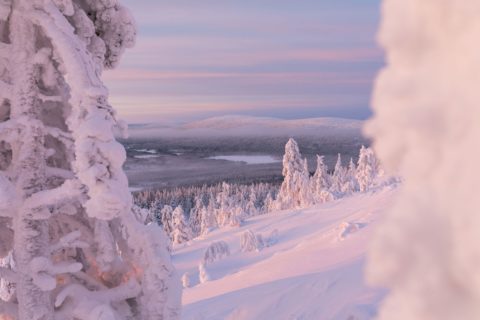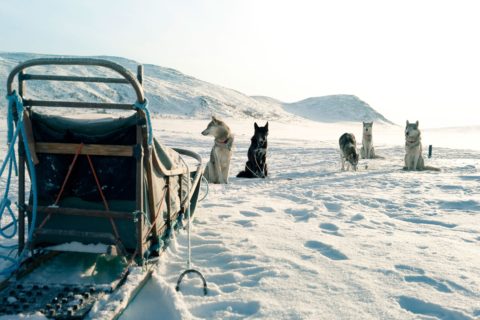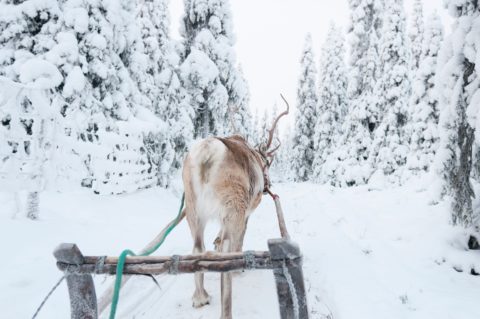Finnish Lapland: A Journey to One of the Most Remote Places on Earth
Reindeer sledding, stunning snowscapes and nightly saunas help ease the chill of Finland’s northernmost region.
The bulbous, teardrop-like shape of the snow-laden pine trees makes it feel like we’re in a Dr. Seuss book. But we’re actually right on the edge of the Arctic Circle. After a mid-January night tucked away in a sleeper bunk on the train from Helsinki, we’ve arrived in Finnish Lapland.
As we slow to our final stop at Kolari, Finland’s most northerly station, the train empties of Finnish parents wrangling their overexcited kids and heavy bags bursting with ski gear. I’m among a group of eight well-travelled women who have flown in from all over the world to join Intrepid Travel’s eight-day Finnish Lapland in Winter tour.
While it’s a coincidence that our group is 100 per cent female, Gundega Liepina, our seasoned tour leader, isn’t surprised. “If you are the type of woman with a sense of mind to experience something new, you come to this destination,” says Liepina, who is from Latvia but has led tours in the Baltic and Arctic regions for many seasons. “They are women who want to have an adventure. They want to face a little bit of physical difficulty and are not afraid of it.”

Finnish Lapland is one of the most remote places on earth, but thanks to Finland’s excellent infrastructure (hello, good Wi-Fi!) and social programs, these communities—which rely on adventure tourism, ski resorts, fishing, agriculture and reindeer farming—thrive.
Sure, the temperature may plunge to –50ºC while the snow piles up to 90 centimetres in Lapland’s more remote areas, but grandparents and kindergartners alike navigate the well-lit ski paths that run beside the roads, deftly pushing their kicksleds (a seat attached to ski rails) to school, to the grocery store or to meet friends for a strong coffee and a slice of mustikkapiirakka (bilberry pie). “Life is very much up to the weather,” says Liepina. “Laplanders live in such a close connection with nature and animals because they are all deeply codependent.”
“Laplanders live in such a close connection with nature and animals because they are all deeply codependent.”
Staying on the edge of Pallas-Yllästunturi National Park in the family-run hotel and hostel Kuerkievari—where nightly saunas are encouraged and Scandi-chic decor runs throughout—we’re in a perfect position to test ourselves in those intense elements (especially the two Australians in our group who have never seen real snow before).
On our first full day, merino-wool base layer on and ski goggles in hand (this Canadian girl came prepared), I’m introduced to the team of six female huskies that I’m about to run through the snow-pine forest. In Lapland, there’s no sitting back; here, you drive the dogs yourself.

I get some quick instructions on how to break and corner from Melina, the no-fuss trainer who races her team professionally throughout the Arctic regions, as she picks up these massive full-grown dogs as if they were puppies. My canine team intuits that we’re about to leave, and their barking grows to deafening levels. Then we’re off, streaking across a stunning snowscape with the orange glow of the slow-to-rise 11 a.m. sun just starting to graze the tops of the pines and the wind blowing hard in my face. The dogs are in heaven racing along the icy track, and so am I—the thrill of the speed and the feeling of it being just me and the dogs alone in this eerie white world (with an experienced trainer just up ahead if something goes wrong) are unparalleled.
We finish our adventurous morning roasting reindeer sausages on an open fire inside a cozy hut, huddled together on benches covered in reindeer hides, sipping cups of hot berry juice and talking about the dogs, the trainers’ daily lives and what it’s like to be north of the Arctic Circle year-round. “Nobody cares if you’re wearing makeup or what brand of clothes you have on,” says Liepina. “What’s more important is your inner and outer strength—that’s what [Laplanders] actually value the most.”
“Everything about this place is special: how people live here, how you can be so remote yet still so connected with everything—with nature, with animals and with your deeper self.”
The next day, we take a trip to Sammun Tupa, a 158-year-old reindeer farm, and meet up with Tiina Kiuttu, a local reindeer herder who has lived in Lapland her whole life. She explains that although the region’s 200,000 reindeer (that’s more reindeer than humans) can be found grazing in the forest, none of them are completely wild. Each reindeer you see in Lapland belongs to a specific herder, indicated by marks on its ears, and—as is tradition—most herds have been inherited.

“Reindeer usually like to use the same roads in the wilderness for years and years and years,” says Kiuttu. “That’s why when we need to catch them, we know where to go.”
We not only meet some of these magnificent creatures but also get to experience how the Sámi, the Indigenous Laplanders, have been transporting themselves and their goods for thousands of years.
“Keep your hands and feet inside because there are trees along the way,” says Kiuttu as she single-handedly harnesses a giant reindeer to our two-person wooden sled and tucks a reindeer hide around our knees.
Our reindeer caravan gently makes its way through the woods, the crunch of their hooves and puffs of hot breath accenting the journey. As we glide under twisted, snow-laden branches and through the cold air sparkling with ice crystals (today the temperature has dropped to –26ºC), it’s hard not to get swept away by the magic that this landscape provides. “Everything about this place is special: how people live here, how you can be so remote yet still so connected with everything—with nature, with animals and with your deeper self,” says Liepina.

On our last night, at around 2 a.m. I’m woken up by a knock on my door and an excited, hushed shout of “The aurora is here! The aurora is here!” We’d been using the My Aurora app to track the best time to see the Northern Lights, setting alarms to get up and check throughout the week.
Eight women quickly throw on insulated snowsuits and boots and silently gather, steps from our red-and-white hotel on the side of a mountain, staring slack-jawed as the wavy green sheets of the aurora borealis work their way across the clear, starry sky for the next half-hour.
In the awed silence, I can’t help but think about everything I’ve seen and the strong women I’ve met in the past week. Dr. Seuss wrote in Oh, the Places You’ll Go! that “you can steer yourself any direction you choose,” and up here in Lapland, that’s certainly true.








